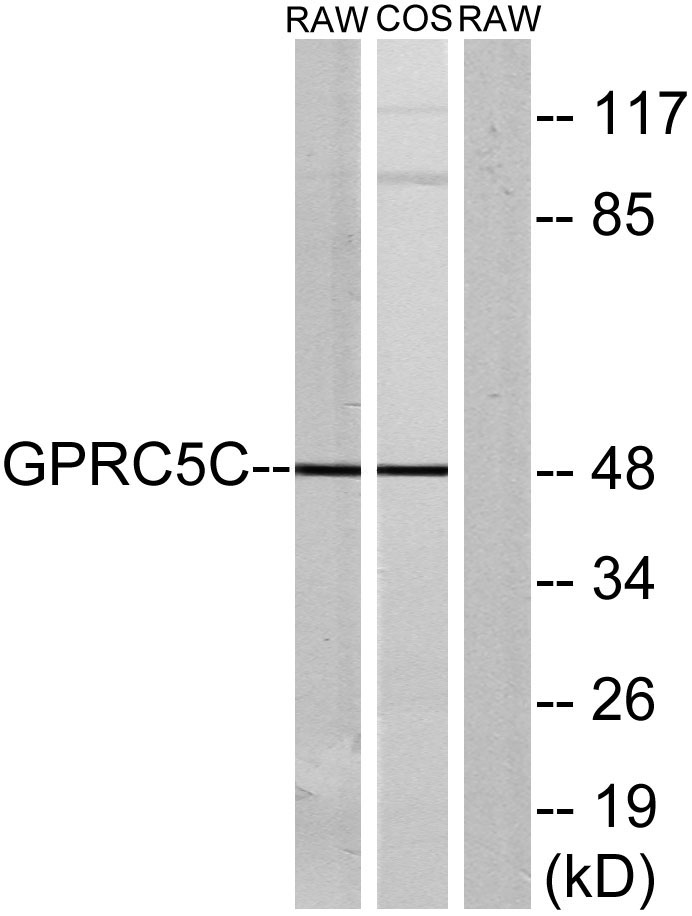GPRC5C Polyclonal Antibody
- Catalog No.:YT2038
- Applications:WB;IF;ELISA
- Reactivity:Human;Mouse;Rat;Monkey
- Target:
- GPRC5C
- Gene Name:
- GPRC5C
- Protein Name:
- G-protein coupled receptor family C group 5 member C
- Human Gene Id:
- 55890
- Human Swiss Prot No:
- Q9NQ84
- Mouse Gene Id:
- 70355
- Mouse Swiss Prot No:
- Q8K3J9
- Rat Swiss Prot No:
- Q3KRC4
- Immunogen:
- The antiserum was produced against synthesized peptide derived from human GPRC5C. AA range:51-100
- Specificity:
- GPRC5C Polyclonal Antibody detects endogenous levels of GPRC5C protein.
- Formulation:
- Liquid in PBS containing 50% glycerol, 0.5% BSA and 0.02% sodium azide.
- Source:
- Polyclonal, Rabbit,IgG
- Dilution:
- WB 1:500 - 1:2000. IF 1:200 - 1:1000. ELISA: 1:5000. Not yet tested in other applications.
- Purification:
- The antibody was affinity-purified from rabbit antiserum by affinity-chromatography using epitope-specific immunogen.
- Concentration:
- 1 mg/ml
- Storage Stability:
- -15°C to -25°C/1 year(Do not lower than -25°C)
- Other Name:
- GPRC5C;RAIG3;PSEC0087;G-protein coupled receptor family C group 5 member C;Retinoic acid-induced gene 3 protein;RAIG-3
- Observed Band(KD):
- 48kD
- Background:
- The protein encoded by this gene is a member of the type 3 G protein-coupled receptor family. Members of this superfamily are characterized by a signature 7-transmembrane domain motif. The specific function of this protein is unknown; however, this protein may mediate the cellular effects of retinoic acid on the G protein signal transduction cascade. Two transcript variants encoding different isoforms have been found for this gene. [provided by RefSeq, Jul 2008],
- Function:
- function:Unknown. This retinoic acid-inducible G-protein coupled receptor provide evidence for a possible interaction between retinoid and G-protein signaling pathways.,induction:By all-trans retinoic acid (ATRA).,PTM:Phosphorylated upon DNA damage, probably by ATM or ATR.,similarity:Belongs to the G-protein coupled receptor 3 family.,subcellular location:Localized in the plasma membrane and perinuclear vesicles.,tissue specificity:Expression is highest in the periphery, particularly in the stomach, but also in the kidney, liver, pancreas, and prostate. In brain, levels of expression are generally lower than in the periphery, with the exception of cerebellum, spinal cord, and dorsal root ganglia (DRG).,
- Subcellular Location:
- Cell membrane; Multi-pass membrane protein. Cytoplasmic vesicle membrane; Multi-pass membrane protein. Localized in the plasma membrane and perinuclear vesicles.
- Expression:
- Expression is highest in the periphery, particularly in the stomach, but also in the kidney, liver, pancreas, and prostate. In brain, levels of expression are generally lower than in the periphery, with the exception of cerebellum, spinal cord, and dorsal root ganglia (DRG).
- June 19-2018
- WESTERN IMMUNOBLOTTING PROTOCOL
- June 19-2018
- IMMUNOHISTOCHEMISTRY-PARAFFIN PROTOCOL
- June 19-2018
- IMMUNOFLUORESCENCE PROTOCOL
- September 08-2020
- FLOW-CYTOMEYRT-PROTOCOL
- May 20-2022
- Cell-Based ELISA│解您多样本WB检测之困扰
- July 13-2018
- CELL-BASED-ELISA-PROTOCOL-FOR-ACETYL-PROTEIN
- July 13-2018
- CELL-BASED-ELISA-PROTOCOL-FOR-PHOSPHO-PROTEIN
- July 13-2018
- Antibody-FAQs
- Products Images

- Western blot analysis of lysates from RAW264.7 and COS7 cells, using GPRC5C Antibody. The lane on the right is blocked with the synthesized peptide.



